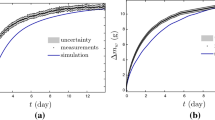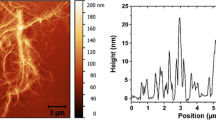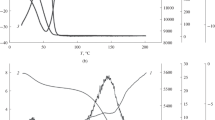Abstract
The theory of mass transport in porous media is of fundamental importance for different applications such as food, paper packaging, textiles, and wood for building materials. In this study, a theoretical water vapor transport model has been developed for cellulose-based materials, such as paper and regenerated cellulose film. Pore diffusivities were determined from the dynamic moisture breakthrough experiments comprising a stack of paper sheets and regenerated cellulose films in a configuration similar to a packed adsorption column. Other mass transfer parameters were determined from transient moisture uptake rate measurements. The model incorporates pore and surface diffusion as a lump parameter into a variable effective diffusion coefficient. The mass transport, involving both pore and surface diffusions, is evaluated independently. The theoretical water vapor transmission rates (WVTRs) obtained from the model were compared with experimentally determined WVTRs measured under steady-state conditions. The theoretical model, based on intrinsic diffusion, stipulates higher WVTR values compared to the experimental results. However, the theoretical water vapor transfer rates agree well with the experimental results when external mass transfer resistance is incorporated in the model.










Similar content being viewed by others
References
Ahlen AT (1970) Diffusion of sorbed water vapor through paper and cellulose film. Tappi J 53(7):1320–1326
Anderson RB (1946) Modifications of the brunauer, emmett and teller equation. J Am Soc 68:681–691
Bandyopadhyay A, Ramarao BV, Ramaswamy S (2002) Transient moisture diffusion through paperboard materials. Colloids Surf A Physicochem Eng Asp 206:455–467
Bedane AH, Huang Q, Xiao H, Eić M (2012) Mass transfer of water vapor, carbon dioxide and oxygen on modified cellulose fiber-based materials. J Nord Pulp Paper Res 27(2):409–417
Bedane AH, Xiao H, Eić M (2014) Water vapor adsorption equilibria and mass transport in unmodified and modified cellulose fiber-based materials. J Adsorption 20(7):863–874
Bedane AH, Xiao H, Eić M, Madjid FF (2015) Water vapor transport properties of regenerated cellulose and nanofibrillated cellulose films. J Membr Sci 493:46–57
Belbekhouchea S, Brasb J, Siqueirab G, Chappeya C, Lebruna L, Khelifib B, Maraisa S, Dufresneb A (2011) Water sorption behavior and gas barrier properties of cellulose whiskers and microfibrils films. Carbohydr Polym 83(4):1740–1748
Bhatt BJ (2012) Regenerated cellulose for controlled oral drug delivery. PhD thesis, University of Iowa. http://ir.uiowa.edu/etd/4577
Chatterjee SG, Ramarao BV, Tien C (1997) Water-vapor sorption equilibria of a bleached-Kraft paperboard-a study of hysteresis region. J Pulp Paper Sci 23(8):366–373
Chen YD, Yang RT (1993) Surface diffusion of multilayered adsorbed species. AIChE J 39(4):559–606
Crank J, Park GS (1968) Diffusion in Polymers. Academic Press, London
Defrenne Y, Zhdankin V, Takagaki S, Ramaswamy S, Lavrykov S, Ramarao B (2009) Multi-scale moisture transport in paper: Impact of pore and fiber tortuosity and anisotropy. Proc Advances in Pulp and Paper Research pp 455–473
Del Nobile MA, Fava P, Piergiovanni L (2002) Water transport properties of cellophane flexible films intended for food packaging applications. J Food Eng 53:295–300
Epstein N (1989) On tortuosity and the tortuosity factor in flow and diffusion through porous media. Chem Eng Sci 44:777–779
Foss WR, Bronkhorst CA, Bennett KA (2003) Simultaneous heat and mass transport in paper sheets during moisture sorption from humid air. Int J Heat Mass Transfer 46:2875–2886
Gupta H, Chatterjee SG (2003a) Parallel diffusion of moisture in paper. Part 1: steady-state conditions. Ind Eng Chem Res 42:6582–6592
Gupta H, Chatterjee SG (2003b) Parallel diffusion of moisture in papers. Part 2: transient conditions. Ind Eng Chem Res 42:6593–6600
Hashimoto A, Stenstrom S, Kameoka T (2003) Simulation of convective drying of wet porous materials. Drying Tech 21(8):1411–1431
Hedenqvist M, Gedde UW (1996) Diffusion of small molecule penetrants in semicrystalline polymers. Prog Polym Sci 21:299–333
Henriksson M, Berglund LA, Isaksson P, Lindstrom T, Nishino N (2008) Cellulose nanopaper structures of high toughness. Biomacromolecules 9(6):1579–1585
Hines AL, Maddox RN (1985) Mass transfer fundamentals and applications. Prentice-Hall Inc, Englewood Cliffs
Ichwan M, Son TW (2011) Preparation and characterization of dense cellulose film for membrane application. J Appl Polym Sci 124(2):1409–1418
Karger J, Ruthven DM (1992) Diffusion in zeolites and other microporous solids, Chapter 9. Wiley, New York
Khare VP, Greenberg AR, Kelley SS, Pilath H, Roh J II, Tyber J (2007) Synthesis and characterization of dense and porous cellulose films. J Appl Sci 105:1228–1236
Liang B, Fields RJ, King JC (1990) The mechanisms of transport of water and n-propanol through pulp and paper. Dry Tech 8(4):641–665
Lin SH (1990) Moisture absorption in cellulosic materials. Int J Eng Sci 28(11):1151–1156
Liu H, Ruthven DM (1996) Diffusion in carbon molecular sieves. Fundament Adsorption 356:529–536
Lonsdale HK (1982) The growth of membrane and technology. J Membr Sci 10:81–181
Massoquete A (2005) Study of Anisotropic moisture diffusion in paper materials. PhD thesis. State University of New York College of Environmental Science and Forestry Syracuse, New York
Matyka M, Khalili A, Koza Z (2008) Tortuosity-porosity relation in porous media flow. Phys Rev E 78:026306
Morillon V, Debeaufort F, Blond B, Capelle M, Voilley A (2002) Factors affecting the moisture permeability of lipid-based edible films: a review. Crit Rev Food Sci Nutr 42(1):67–89
Nagy E (2012) Basic equations of the mass transport through a membrane layer. Waltham, MA 02451, USA, Elsevier Inc. pp 6–29
Nair SS, Zhu JY, Deng Y, Ragauskas AJ (2014) High performance green barriers based on nanocellulose. Sustain Chem Process 2:23. doi:10.1186/s40508-014-0023-0
Nilsson L, Wilhelmsson B, Stenstrom S (1993) The diffusion of water vapor through pulp and paper. Drying Tech. 11(6):1205–1225
Pangarkar VG, Ray SK (2015) Pervaporation: theory, practice, and applications in the chemical and allied industries. Handbook of membrane separations–chemical, pharmaciutical, food, and biotechnological applications. Taylor and Francis Group, Boca Raton, pp 81–202
Pascat B (1986) Study of some factors affecting permeability. In: Mathlouthi M (ed) Food packaging and preservation. Theory and practice. Elsevier Applied Science Publishers, London, pp 7–24
Radhakrishnan H, Chatterjee SG, Ramarao BV (2000) Steady-state moisture transport in a bleached Kraft paperboard stack. J Pulp Paper Sci 26(4):140–144
Ramarao BV, Massoquete A, Lavrykov S, Ramaswamy S (2003) Moisture diffusion inside paper materials in the hygroscopic range and characteristics of diffusivity parameters. Dry Tech 21(10):2007–2056
Rogers CE (1985) Permeation of gases and vapors in polymers. In: Comyn J (ed) Polymer permeability. Elsevier Applied Science Publishers, New York, pp 11–73
Ruthven DM (1984) Principle of adsorption and adsorption processes. Wiley, New York
Spence KL, Venditti RA, Rojas OJ, Pawlak JJ, Hubbe MA (2011) Water vapor barrier properties of coated and filled microfibrillated cellulose composite films. Bioresources 6(4):4370–4388
Sun Z, Tang X, Cheng G (2013) Numerical simulation for tortuosity of porous media. Microporous Mesoporous Mater 173:37–42
Tolle WE (1971) Variables affecting film permeability requirements for modified-atmosphere. Agricultural Research Service. U.S Department of Agriculture, Technical Bulletin No. 1422
Topgaard D, Soderman O (2001) Diffusion of water absorbed in cellulose fibers studied with H-NMR. Langmuir 17:2694–2702
Yang Q, Fukuzumi H, Saito T, Isogai A, Zhang L (2011) Transparent cellulose films with high gas barrier properties fabricated from aqueous alkali/urea solutions. Biomacromolecules 12:2766–2771
Yang Q, Saito T, Isogai A (2012) Facile fabrication of transparent cellulose films with high water repellency and gas barrier properties. Cellulose 19:913–1921
Acknowledgments
The authors gratefully acknowledge financial support from the Natural Sciences and Engineering Research Council of Canada (NSERC) Strategic Green Fiber Network program. We also thank Dr. Xiao’s graduate student, Ms. Zhaoping Song, for preparation of the samples in the UNB Limerick Pulp and Paper Laboratory.
Author information
Authors and Affiliations
Corresponding author
Electronic supplementary material
Below is the link to the electronic supplementary material.
Appendix: Calculated result for the Knudsen diffusion coefficient
Appendix: Calculated result for the Knudsen diffusion coefficient
Knudsen diffusion is a means of molecular transport through pores that are small in comparison to the mean free path of the gas. For straight and round pores, the Knudsen diffusion coefficient can be predicted from the diameter of the pore by the expression (Hines and Maddox 1985):
where r is the pore radius, m, T is temperature, K, D A,K is the Knudsen diffusion coefficient, m2/s, and M A is the molecular weight of component A.
In order to account for the tortuosity path of the molecule (τ) and the porosity of the material (ε), an effective Knudsen diffusivity (D A,K,e) can be expressed as:
Regenerated cellulose film has a small mean pore size and ranges between 0.5 to 2.0 nm (Tolle 1971; Ichwan and Son 2011). It is possible that the regenerated cellulose film exhibits a dominant Knudsen diffusion mechanism. Molecules collide more often with the pore walls than with other molecules in the Knudsen diffusion mechanism. Assuming straight and round pores in the cellulose film, the effective diffusivity can be calculated using Eq. 26.
The calculated D A,K,e is found to be around 5.3 × 10−9 m2/s using the porosity value, ε = 0.20, tortuosity, τ = 15, molecular weight of the water vapor molecule, M A = 18 g/mol, T = 298 K, and pore radius, r ≈ 1.25 nm.
Rights and permissions
About this article
Cite this article
Bedane, A.H., Eić, M., Farmahini-Farahani, M. et al. Theoretical modeling of water vapor transport in cellulose-based materials. Cellulose 23, 1537–1552 (2016). https://doi.org/10.1007/s10570-016-0917-y
Received:
Accepted:
Published:
Issue Date:
DOI: https://doi.org/10.1007/s10570-016-0917-y




